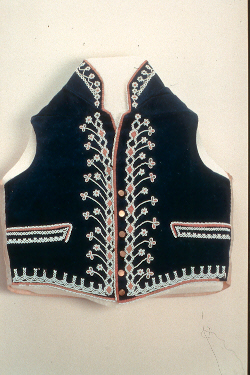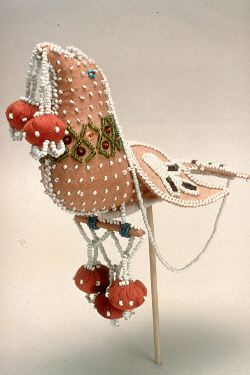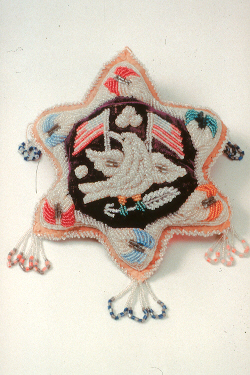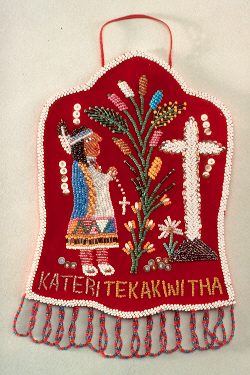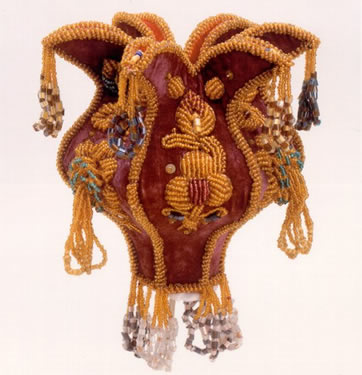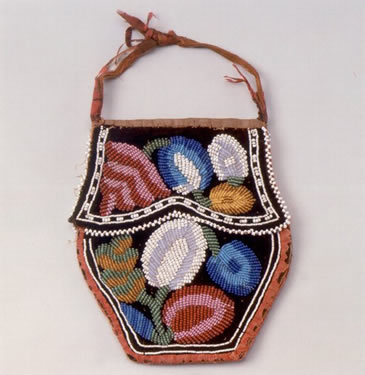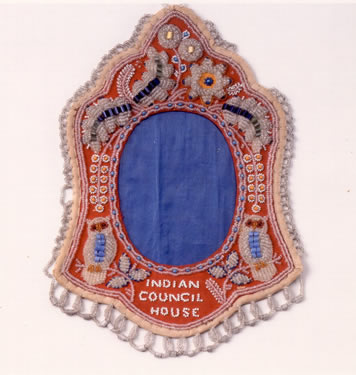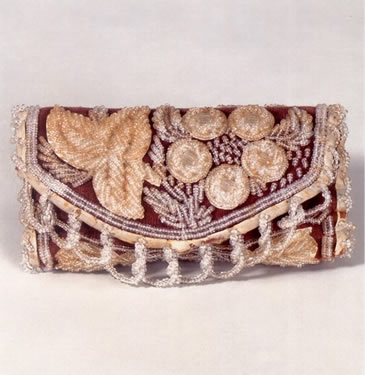| From striking beaded clothing
to souvenir beaded pincushions, the artistic, cultural, economic
and political significance of beadwork in the lives of Iroquois
people is explored in a new exhibition, titled Across Borders: Beadwork
in Iroquois Life. More than 300 examples of stunning beadwork, including
moccasins, picture frames, and bags, will be on display to illustrate
how placing thousands of tiny glass beads on fabric is ultimately
linked to the identity and survival of Iroquois people. The exhibition
traces the story of Iroquois beadwork from pre-European contact
to the present. |
| |
|
|
|
|
Iroquois Waistcoat
Mid 19th century
Maker Unknown, Canada
W.C. Wyman Collection
Smithsonian Institution
(17.9689)
|
Mohawk Bird Figure
1906, Maker Unknown
Kahnawake, Ontario
NMAI Collection
Smithsonian Institution
(21.9044)
|
| |
|
"This exhibition tells the fascinating
story of how Native peoples have adapted traditional tribal aesthetics
to new products that were marketed to a diverse network of consumers,"said
W. Richard West, the director of the National Museum of the American
Indian. "'Across Borders' also symbolizes how many Native
cultures have remained vibrant by adapting deftly to surrounding
influences while, at the same time, staying true to the spirit
of their communities."
Through thematic sections, the exhibition
tells the stories of the Iroquois universe, the development of
beadwork, the interaction of Iroquois and Victorian aesthetics,
the entrepreneurial skills of the Iroquois, and how contemporary
Iroquois beadworkers have reinvented the language of beadwork.
|
| |
|
|
|
|
Mohawk Pincushion
ca. 1850-1910
Maker Unknown, Canada
NMAI Collection
Smithsonian Institution
(20.2659)
|
Mohawk Wall Hanging
1955 by Mrs. Lazar
Kahnawake, Ontario
NMAI Collection
Smithsonian Institution
(24.4407)
|
| |
| The Iroquois people live
on territories that border New York State, Quebec and Ontario. During
the 19th century, Iroquois artists developed a remarkable new style
of beadwork—"tourist art"—that was a blend of
traditional Iroquois designs with popular Victorian fashions. Vibrantly
colored beadwork spilled across the fabric of souvenir pincushions,
picture frames and wallpockets designed to appeal to throngs of
eager tourists visiting popular resorts such as Niagara Falls and
Saratoga. Spanning the turn of the century, the sale of souvenir
art was the cornerstone of new Iroquois economies. |
| |
|
|
|
|
Mohawk Hanging Basket
ca. 1850-1910
Collected at Kahnawake, Ontario, Canada
National Museum of the American Indian Collection
Smithsonian Institution
(22.2468)
|
Tuscarora Beaded Bag
ca. 1890, Grand River Reserve, Ontario, Canada
Collected by Joseph Keppler
National Museum of the American Indian Collection
Smithsonian Institution
(01.1733)
|
|
|
|
|
|
| Today, as always, Iroquois
people continue to maintain their strong link to an artistic tradition
that resonates with their beliefs, sense of identity and community
values. Women create the elaborately beaded garments worn at political
events and also make beaded Christmas decorations. On the international
scene, contemporary Iroquois artists are creating innovative works
that, while inspired by beadwork, move across conceptual boundaries
and challenge viewers to reflect on the events that have shaped
the history of Native and non-Native relations. In sum, "Across
Borders" takes visitors on a trip that crosses many borders—from
the past to the future, from art to craft, from cosmology to everyday
events, and most importantly, from isolation to a new shared space
where both Native and nonnative people will better understand their
complex and interwoven history. |
| |
|
|
|
|
Seneca Picture Frame
ca. 1890, Maker Unknown
Collected by William Stiles from Jessie Cornplanter
National Museum of the American Indian Collection
Smithsonian Institution
(24.1371)
|
Tuscarora Needlecase
ca. 1850-1910
Maker Unknown
National Museum of the American Indian Collection
Smithsonian Institution
(21.7414)
|
|
|
|
| |
| "Across Borders: Beadwork
in Iroquois Life" is a traveling exhibition organized by the
McCord Museum of Canadian History in Montreal, Quebec, Canada, in
partnership with the Castellani Art Museum of Niagara University,
Lewiston, N.Y., with the participation of the Kanien’kehaka
Raotitiohkwa Cultural Center, Kahnawake, Quebec; the Tuscarora community
of western New York state; and the Royal Ontario Museum, Toronto,
Ontario. |
| |
National Museum of the
American Indian
http://www.nmai.si.edu/
|
|

